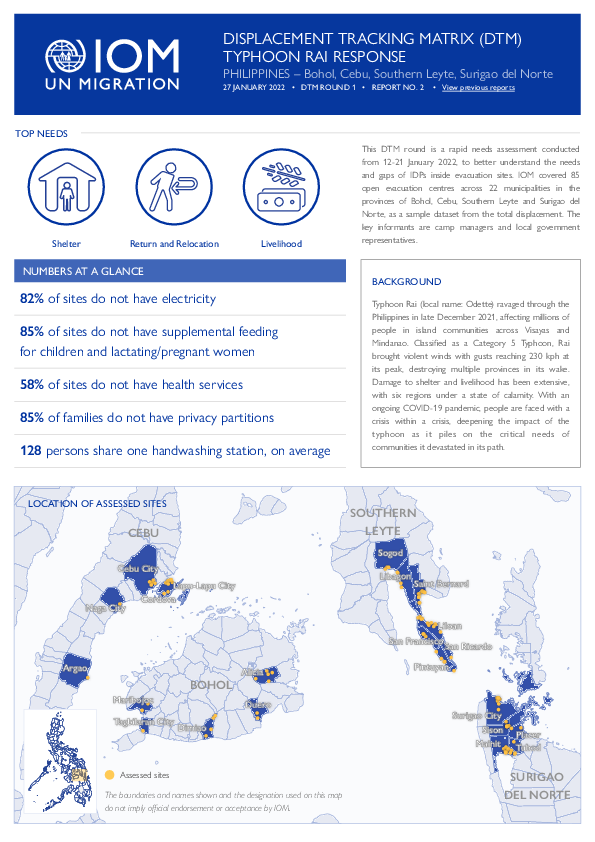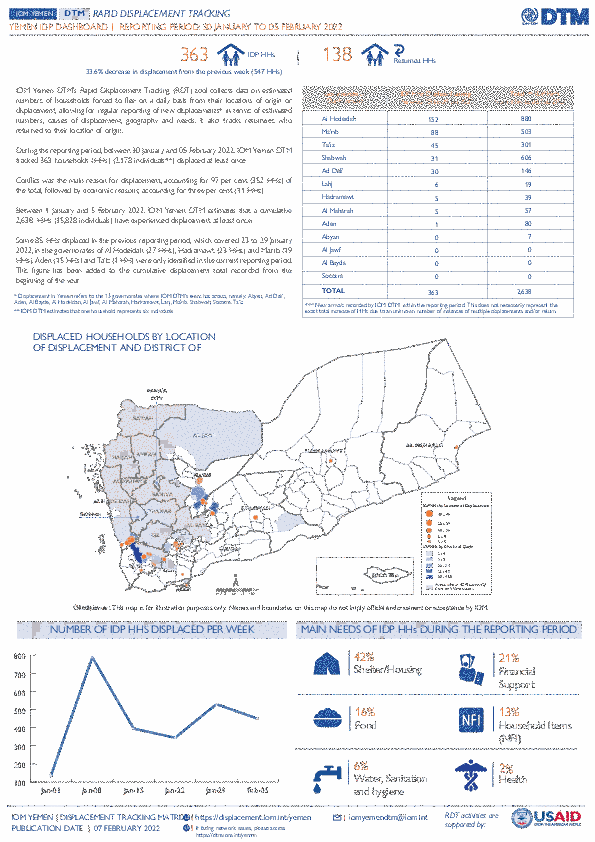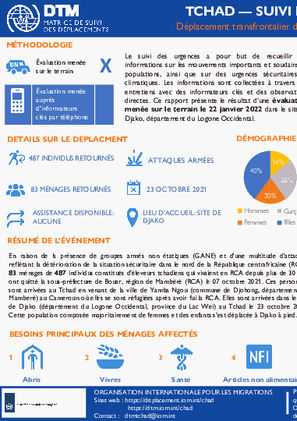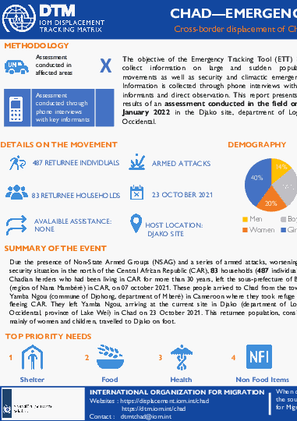-
Countries
-
Data and Analysis
-
Special Focus
-
Crisis Responses

Contact
DTM Iraq, IraqDTM@iom.int
Language
English
Location
Iraq
Period Covered
Oct 01 2021
Dec 31 2021
Activity
- Mobility Tracking
- Baseline Assessment
Data collection for Round 124 took place between October and December 2021. As of 31 December 2021, DTM identified 4,952,232 returnees (825,372 households), dispersed across eight governorates, 38 districts, and 2,179 locations in Iraq. A lower number of new returnees were recorded in Round 124 (13,158) compared with Round 123 (54,462) between August-September 2021. However, the higher number in Round 123 is partially attributable to DTM data collection teams assessing some locations in Anbar governorate in that round that had previously been inaccessible.
Contact
DTM Iraq, IraqDTM@iom.int
Location
Iraq
Activity
- Mobility Tracking
- Baseline Assessment
Period Covered
Oct 01 2021 -Dec 31 2021
The Return Index is a tool designed to measure the severity of conditions in locations of return. The Return Index is built on a list of indicators developed to reflect the displacement context in Iraq. It is based on 16 indicators grouped into two scales: Scale 1, on livelihoods and basic services, and Scale 2, centered around social cohesion and safety perceptions. The scores of the index, scales and all answers are grouped into three categories of severity: ‘low’, ‘medium’ and ‘high’.
During this round of data collection, DTM has identified 4,948,104 returnees (824,684 households), dispersed across 8 governorates, 38 districts and 2,165 locations in Iraq.
Population Groups
Survey Methodology
Unit of Analysis Or Observation
Type of Survey or Assessment
Keywords
Geographical Scope
Administrative boundaries with available data
The current dataset covers the following administrative boundaries

Contact
tdooley@iom.int
Language
English
Location
Philippines
Period Covered
Jan 12 2022
Feb 21 2022
Activity
- Site Assessment
- Mobility Tracking
Typhoon Rai (local name: Odette) ravaged through the Philippines in late December 2021, affecting millions of people in island communities across Visayas and Mindanao. Classified as a Category 5 Typhoon, Rai brought violent winds with gusts reaching 230 kph at its peak, destroying multiple provinces in its wake. Damage to shelter and livelihood has been extensive, with six regions under a state of calamity. With an ongoing COVID-19 pandemic, people are faced with a crisis within a crisis, deepening the impact of the typhoon as it piles on the critical needs of communities it devastated in its path.
This DTM round is a rapid needs assessment conducted from 12-21 January 2022, to better understand the needs and gaps of IDPs inside evacuation sites. IOM covered 85 open evacuation centres across 22 municipalities in the provinces of Bohol, Cebu, Southern Leyte and Surigao del Norte, as a sample dataset from the total displacement. The key informants are camp managers and local government representatives.

Contact
tdooley@iom.int
Language
English
Location
Philippines
Snapshot Date
Jan 17 2022
Activity
- Site Assessment
As a response to the displacements caused by Typhoon Odette, the International Organization for Migration (IOM) deployed the Displacement Tracking Matrix (DTM) programme in Regions VII, VIII, and Caraga, in partnership with the Department of Social Welfare and Development (DSWD) Field Offices.
The objective of the DTM is to collect information on the number of the needs and vulnerabilities of the displaced populations and to provide key information to support humanitarian assistance to the most affected populations. This report provides the initial findings on the data of the Internally Displaced Persons (IDPs) in the evacuation centers (EC).
To date, the province of Southern Leyte has the greatest number of active evacuation centers with 374 ECs housing 54,608 individuals (13,729 families). This is followed by Surigao del Norte with 241 ECs housing 46,571 individuals (12,587 families) and Cebu with 126 ECs housing 27,104 individuals (6,684 families). Dinagat Islands, despite being on the lower half of the provinces with active evacuation centers, has a significant number of displaced individuals in relation to their provincial population. Thus, Southern Leyte, Surigao del Norte, Dinagat Islands, and Cebu need to be prioritized in the provision of Camp Coordination and Camp Management (CCCM) interventions.
Feb 09 2022
Print
Countries in this response
- Active DTM operation
- Past DTM operation

Contact
DTM Burundi, DTMBurundi@iom.int
Language
French
Location
Burundi
Period Covered
Jan 23 2022
Jan 29 2022
Activity
- Event Tracking
- Mobility Tracking
Entre le 23 et le 29 janvier 2022, la DTM a identifié 201 personnes affectées inclues 201 personnes déplacées par des pluies torrentielles dans la provinces de Rutana.

Contact
DTM Yemen, iomyemendtm@iom.int
Language
English
Location
Yemen
Period Covered
Jan 30 2022
Feb 05 2022
Activity
- Rapid Emergency Registration
- Mobility Tracking
IOM Yemen DTM’s Rapid Displacement Tracking (RDT) tool collects data on estimated numbers of households forced to flee on a daily basis from their locations of origin or displacement, allowing for regular reporting of new displacements in terms of estimated numbers, geography, and needs. It also tracks Returnees who returned to their location of origin.
From 01 January 2022 to 5 February 2022, IOM Yemen DTM estimates that 2,638 households (HH) (15,828 Individuals) have experienced displacement at least once.
Since the beginning of 2022, DTM also identified 10 displaced households who left their locations of displacement and either moved back to their place of origin or another location.
Between 30 January and 05 February 2022, IOM Yemen DTM tracked 363 households (2,178 individuals) displaced at least once. The top three governorates and districts where people moved into/within are:
- Al Hodeidah (152 HH) – Hays (137 HH), Al Khukhah (15 HH) districts. Most displacements in the governorate originated from Al Hodeidah and Taiz.
- Marib (88 HH) – Marib City (62 HH), Harib (16 HH), Marib (10 HH) districts. Most displacements in the governorate originated from Marib and Dhamar.
- Taiz (45 HH) – Salah (16 HH), Jabal Habashi (14 HH), Al Mawasit (7 HH) districts. Most displacements in the governorate originated from Taiz and Al Hodeidah.
Most displacements resulted from the increased conflict in the following governorates and districts.
- Al Hodeidah (122 HH) – Hays (109 HH), Jabal Ras (10 HH), Zabid (3 HH) districts.
- Taiz (86 HH) – Maqbanah (54 HH), Jabal Habashi (15 HH), Dimnat Khadir (5 HH) districts.
- Marib (55 HH) – Harib (32 HH), Al Jubah (16 HH), Marib City (6 HH) districts.

Contact
DTM Tchad, dtmtchad@iom.int
Language
English
Location
Chad
Snapshot Date
Oct 23 2021
Activity
- Event Tracking
- Mobility Tracking
Le suivi des urgences a pour but de recueillir des informations sur les mouvements importants et soudains de populations, ainsi que sur des urgences sécuritaires et climatiques. Les informations sont collectées à travers des entretiens avec des informateurs clés et des observations directes. Ce rapport présente le résultat d’une évaluation menée sur le terrain le 22 janvier 2022 dans le site de Djako, département du Logone Occidental.
En raison de la présence de groupes armés non étatiques (GANE) et d'une multitude d'attaques reflétant la détérioration de la situation sécuritaire dans le nord de la République centrafricaine (RCA), 83 ménages de 487 individus constitués d’éleveurs tchadiens qui vivaient en RCA depuis plus de 30 ans, ont quitté la sous-préfecture de Bouar, région de Mambéré (RCA) le 07 octobre 2021. Ces personnes sont arrivées au Tchad en venant de la ville de Yamba Ngou (commune de Djohong, département de Mamberé) au Cameroun où elles se sont réfugiées après avoir fui la RCA. Elles sont arrivées dans le site de Djako (département du Logone Occidental, province du Lac Wei) au Tchad le 23 octobre 2021. Cette population composée majoritairement de femmes et des enfants s’est déplacée à Djako à pied.

Contact
DTM Chad, dtmtchad@iom.int
Language
English
Location
Chad
Snapshot Date
Oct 23 2021
Activity
- Event Tracking
- Mobility Tracking
The objective of the Emergency Tracking Tool (ETT) is to collect information on large and sudden population movements as well as security and climactic emergencies. Information is collected through phone interviews with key informants and direct observation. This report presents the results of an assessment conducted in the field on 22 January 2022 in the Djako site, department of Logone Occidental.
Due the presence of Non-State Armed Groups (NSAG) and a series of armed attacks, worsening the security situation in the north of the Central African Republic (CAR), 83 households (487 individuals) of Chadian herders who had been living in CAR for more than 30 years, left the sous-prefecture of Bouar (region of Nana Mambéré) in CAR, on 07 october 2021. These people arrived to Chad from the town of Yamba Ngou (commune of Djohong, department of Mberé) in Cameroon where they took refuge after fleeing CAR. They left Yamba Ngou, arriving at the current site in Djako (department of Logone Occidental, province of Lake Wei) in Chad on 23 October 2021. This returnee population, consisting mainly of women and children, travelled to Djako on foot.

Contact
DTM Turkey, dtmturkey@iom.int
Language
English
Location
Republic of Türkiye
Period Covered
Jan 01 2022
Jan 31 2022
Activity
- Flow Monitoring Survey
- Flow Monitoring
- Migrants presence
The report presents monthly figures on migrants presence in Turkey, on apprehended/rescued persons on sea, on intercepted persons on land, and on resettlement of Syrians from Turkey.
